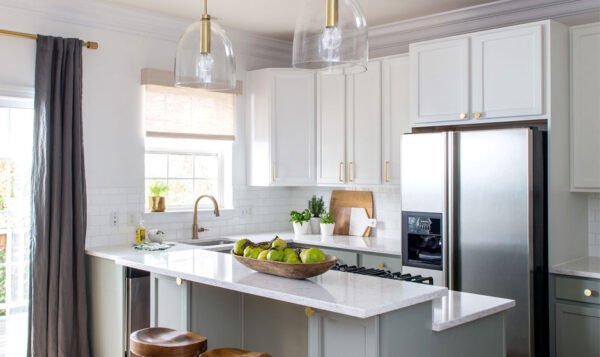8 Home Remodeling Tips for Those on a Budget

Refreshing your home doesn’t mean spending a fortune. You can make meaningful changes that add value to your place without straining your finances. It all boils down to careful planning and picking the right updates that make a big impact. For instance, giving your kitchen a new look or making your living room more inviting can be done affordably.
It’s about being wise with your choices and knowing where you can save some money. The goal is to improve your home’s look and feel without emptying your pockets. Let’s walk through some tips for revamping your space smartly, ensuring that every dollar spent is a step towards a home you love even more.
1. Seek Professional Advice
When you’re aiming to give your home a new look but need to keep an eye on spending, it can be wise to get some expert input. A quick session with an architect or designer could be worth it. They can offer you tailored advice that lets you do the work yourself, cutting down on costs.
These pros often share insights on where to find affordable materials and how to execute a task efficiently. With their guidance, you’ll tackle your project with confidence and keep your budget intact.
Companies such as Joyce Factory Direct do renovation at reasonable prices. This results in further cost savings for you. So be smart, research, and partner with the right professional.
2. Prioritize the Essentials
When planning a remodel, zero in on the must-dos that’ll boost your home’s value and prevent future headaches. It’s wise to put your money where it matters most, ensuring your home stays safe and sound.
- Roof repairs or replacement to prevent water damage
- Updating electrical panels and wiring for safety
- Fixing any plumbing issues to avoid water wastage and damage
- Insulating attics and walls to improve energy efficiency
- Replacing outdated heating or cooling systems to save on utility bills
- Repairing structural damage, such as foundation cracks or termite-ridden beams
3. Opt for Cosmetic Changes
Refreshing your home doesn’t always mean embarking on extensive and costly renovations. Small, aesthetic modifications can make a world of difference. Consider applying a new color to your walls; it’s amazing how this can transform a room.
Upgrading cabinet handles or door knobs is another simple yet effective change. Replacing old light fixtures with new ones brightens the area and enhances the mood. If your floor looks worn, a thorough cleaning or a new rug could do the trick.
Think about swapping out old curtains for something more modern. These updates are straightforward and can be done by most homeowners, leading to a significant impact on your home’s look without a hefty price tag.
4. Shop Smart for Supplies
When you’re looking to cut costs on your home remodel, becoming a savvy shopper is key. Start by exploring sales at your local hardware stores, where you can find significant discounts on essentials. Keep an eye out for discontinued lines, too. Often, these items are priced to clear and can offer great value. Don’t overlook the potential of salvage yards. They can be treasure troves for gently used fixtures and materials that add character to your home without breaking the bank. Here are some tips to shop smart:
- Compare prices at different retailers before purchasing.
- Subscribe to newsletters for early sale alerts.
- Visit reuse centers for quality second-hand materials.
- Negotiate with suppliers for a better deal on bulk buys.
- Consider off-brand products that offer similar quality at lower prices.

5. Do-It-Yourself Where Possible
Rolling up your sleeves and tackling home improvement jobs yourself can lead to big savings. Here’s how you can cut costs without cutting corners:
- Paint your rooms for an instant refresh. Choose your color, grab a brush, and give your walls a new lease on life.
- Lay down tile in your bathroom or kitchen. With a bit of practice and precision, you can create a durable and stylish floor.
- Install new faucets or light fixtures. With basic tools and clear instructions, these upgrades are straightforward and elevate any space.
6. Maintain Existing Layouts
Redesigning your home doesn’t mean you have to start from scratch. Especially in kitchens and bathrooms, where you find a complex network of pipes and wires, it’s wise to work with what you have. Moving sinks, toilets, or appliances isn’t just about the heavy lifting; it involves plumbing and electrical work that adds up quickly. By working within the original framework of your space, you avoid the hefty fees that come with rerouting essential services. This approach not only saves money but also time, allowing you to focus on upgrades that don’t require a complete overhaul.
7. Go for Incremental Upgrades
When you’re updating your home, it’s prudent to focus on one room or project at a time. This approach helps you keep a close eye on spending and avoid the financial strain of a complete overhaul. Spreading out the work means you can adjust your plans according to your budget as you go. For instance, start with the kitchen fixtures this month and maybe tackle the bathroom tiles next.
This method not only keeps your finances in check but also gives you room to breathe and plan each step carefully. It’s a practical way to upgrade your living space without the pressure of a hefty upfront cost.
8. Reuse and Repurpose
When you’re updating your home, it’s a good strategy to take a second look at what you already have. Often, items that seem worn out or outdated can get a new lease on life with a little creativity. Here are practical ways to reuse and repurpose materials during your remodel:
- Cabinets: Freshen up the kitchen by repainting cabinets instead of replacing them.
- Wood: Salvage old wood for new shelving or a coffee table.
- Doors: Turn an old door into a stylish headboard or a unique dining table.
- Fixtures: Update old light fixtures with new paint or use them in a different room.
- Tiles: Mix and match leftover tiles to create a mosaic backsplash.
Conclusion
In wrapping up our guide on budget-friendly home remodeling, remember this. It’s not about how much you spend but how wisely you use what you have. Strategic planning, focusing on essential repairs, and opting for cosmetic changes can lead to significant improvements.



